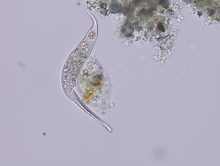- Dileptus anser
-
Dileptus anser 
Dileptus anser Scientific classification Domain: Eukaryota Kingdom: Chromalveolata Superphylum: Alveolata Phylum: Ciliophora Subphylum: Rhabdophora Class: Litostomatea Subclass: Rhynchostomatia Jankowski 1980 Order: Dileptida Family: Dileptidae Genus: Dileptus
Otto Friedrich Müller, 1773Species: Dileptus anser Dileptus anser (Müller, 1773) is a unicellular ciliate protozoan belonging to the genus Dileptus. Specimens range in size between 0.24 and 0.60 mm long, and are found in freshwater streams, lakes and ponds.
Contents
Morphology
Dileptus anser has a "body" shaped like an elongated pear, wider in the front part; a broad and tapering "proboscis", reminiscent of an elephant's trunk in its shape and flexibility, but with a flattened rather than round cross-section; and a flat triangular "tailfin", relatively stiff but steerable, which looks like a sharp thorn in top view. The body usually contains a row of two or more contractile vacuoles along the dorsal surface, numerous macronuclei and hundreds of micronuclei.[1][2]
Feeding habits
Dileptus anser feeds upon other unicellular organisms, almost exclusively in the early morning, between 4am and 9am.[3] It uses its proboscis to strike the prey. The tip of the proboscis may become adhesive, and may be detached if it gets stuck on a larger object (such as a microscope slide) Most of the proboscis may be lost in this way during a feeding period, but is regenerated before the next period. Captured prey is ingested by a "mouth" (cytosome) that opens wide near the base of the trunk.[3] It may however ingest prey directly even without using the proboscis. The mouth is surrounded by toxicysts that sting and paralyze the prey.[4][5]
Reproduction
Like most ciliates, Dileptus anser can reproduce both asexually and sexually. It has three distinct mating types ("sexes"), conventionally designated I, II, and III. Individuals may go through several mating types in the course of their lives. However the final and (usually) stable type is genetically determined by a single genetic locus mat with three three alleles, one for each type, with type I being dominant over type II, and II over III.[6]
See also
- Dileptus
- Lacrymaria olor, another protist with a flexible and extensible "neck".
- Dileptus aculeatus (Dragesco, 1960)
References
- ^ Dileptus anser entry in the Protist Images database. Accessed on 2009-12-27.
- ^ Dileptus anser video at YouTube.com. Accessed on 2009-12-27.
- ^ a b Stephen Miller (2007), The Predatory Behavior of Dileptus anser. Journal of Eukaryotic Microbiology, Volume 15 Issue 2, Pages 313 - 319
- ^ Rosemarie Arbur (2000), Dileptus at Dinnertime. Illustrated online article, Micscape Magazine, issue Nov/2000, Microscopy-UK.org. Accessed on 2009-12-27.
- ^ Rosemarie Arbur (2001), Dessert for Dileptus. Illustrated online article, Micscape Magazine, issue Apr/2001, Microscopy-UK.org. Accessed on 2009-12-27.
- ^ A. L. Yudin and Z. I. Uspenskaya (2006), Mating types in the ciliate Dileptus anser. Inheritance and genetic determination. Citologiâ volume 48, issue 4, pp. 364-374 ISSN 0041-3771. Abstract at inst.fr.
Categories:- Ciliates
Wikimedia Foundation. 2010.
